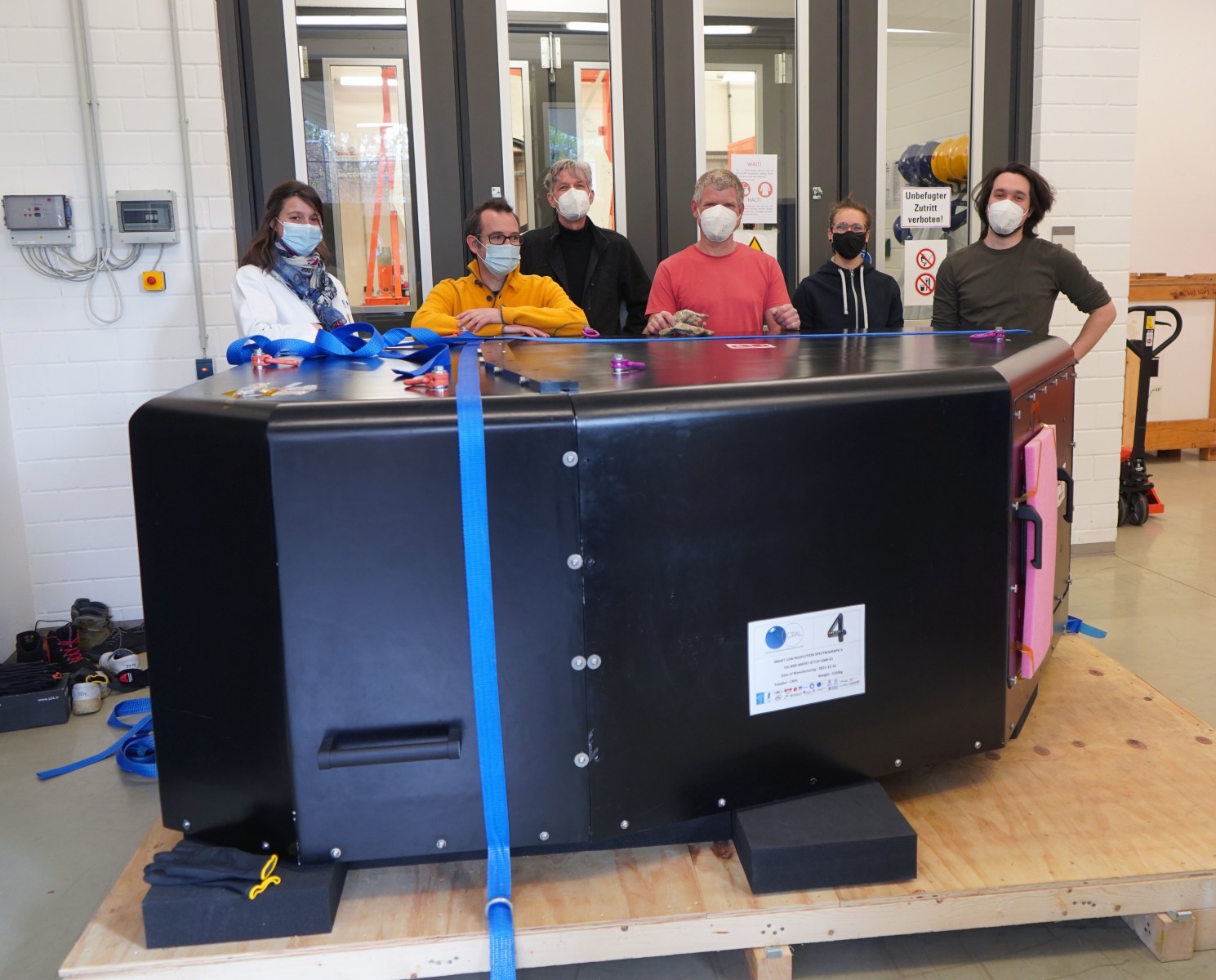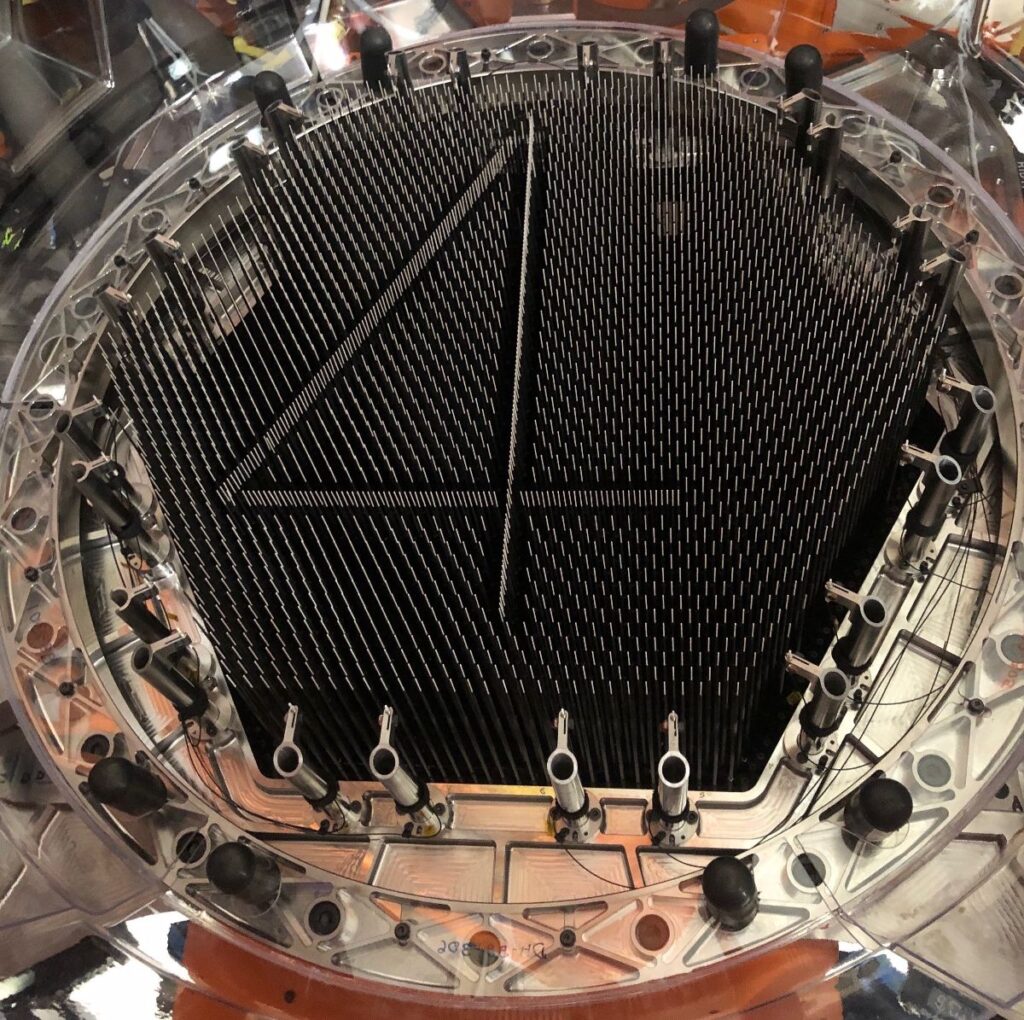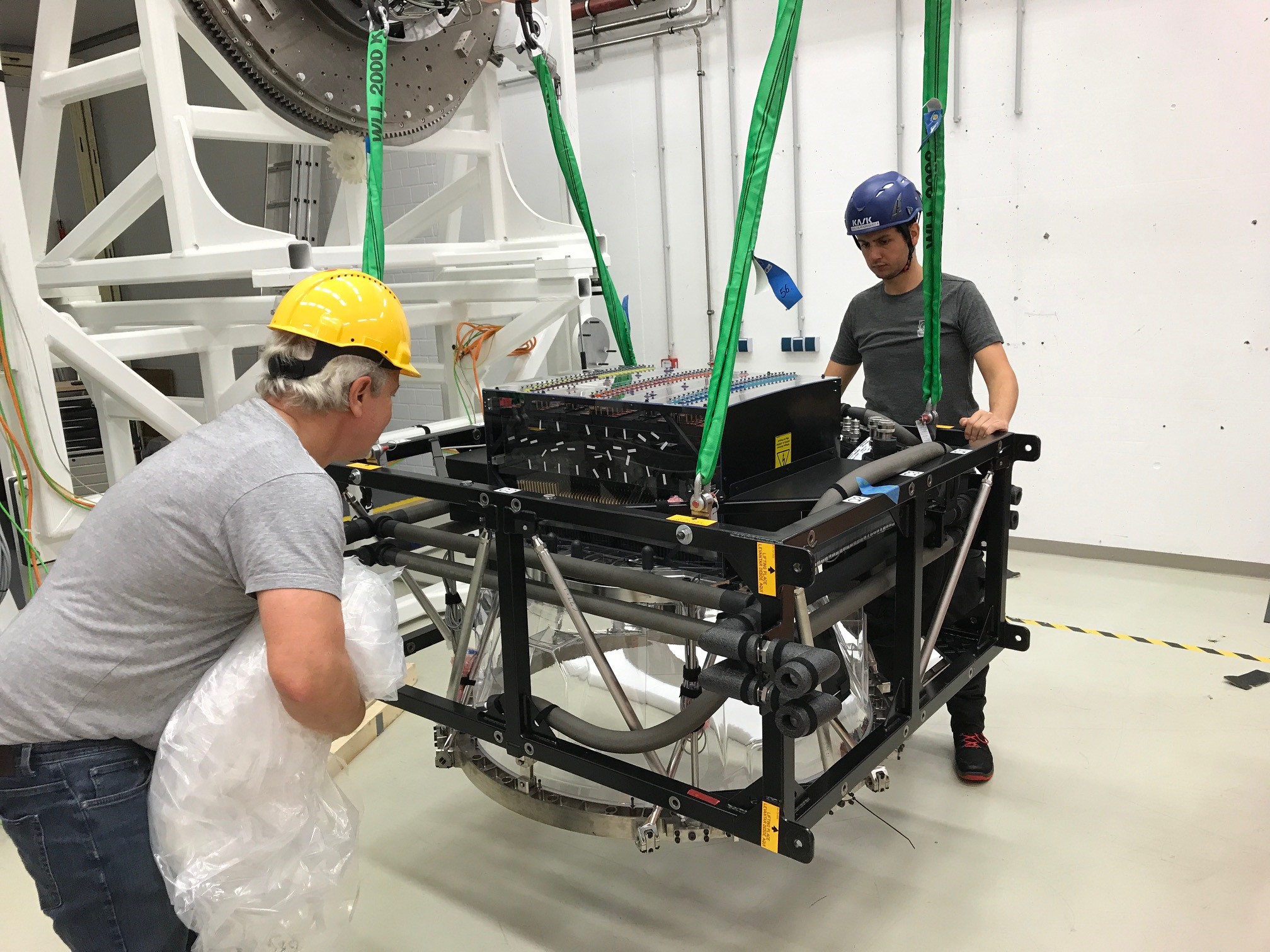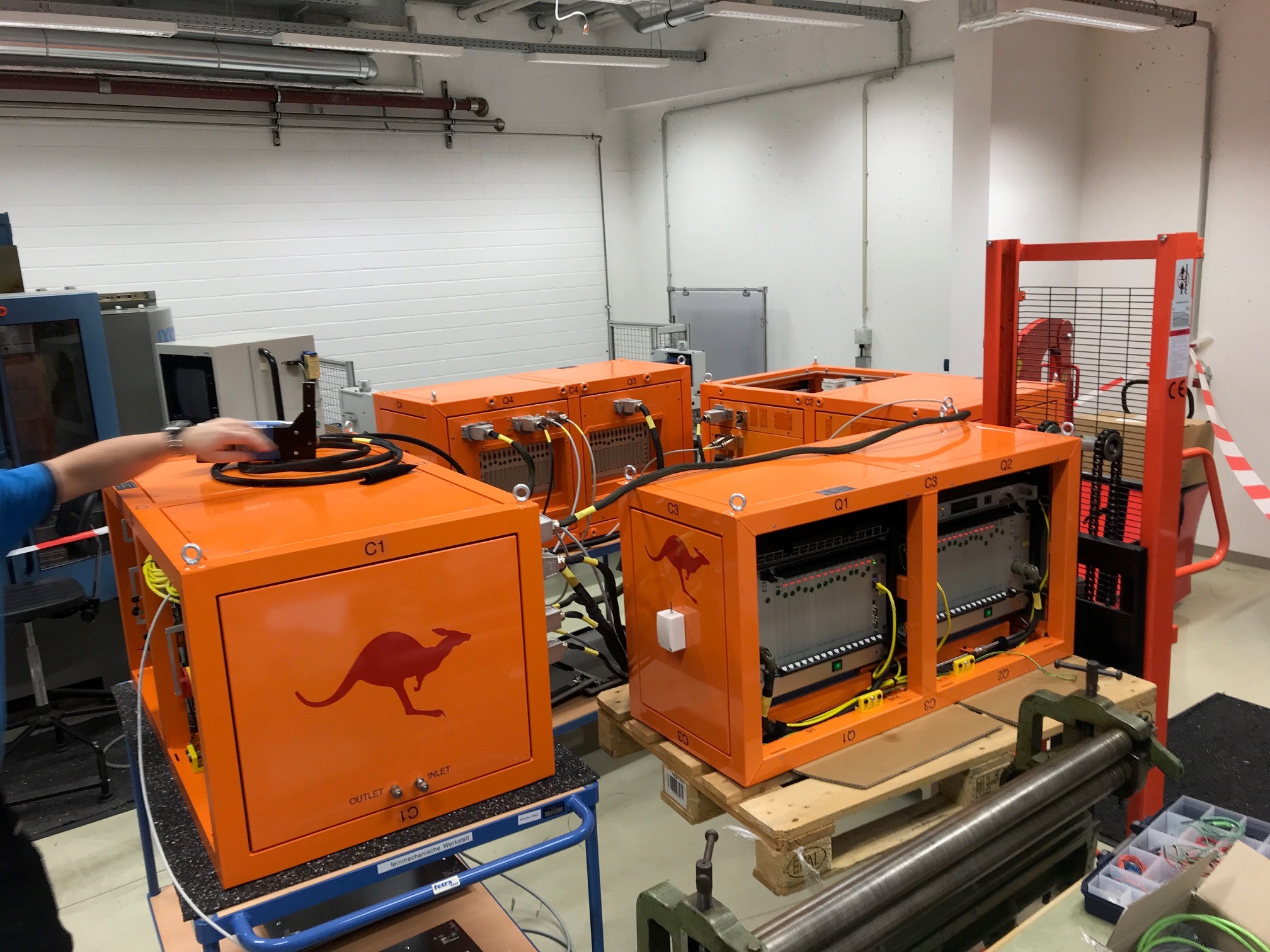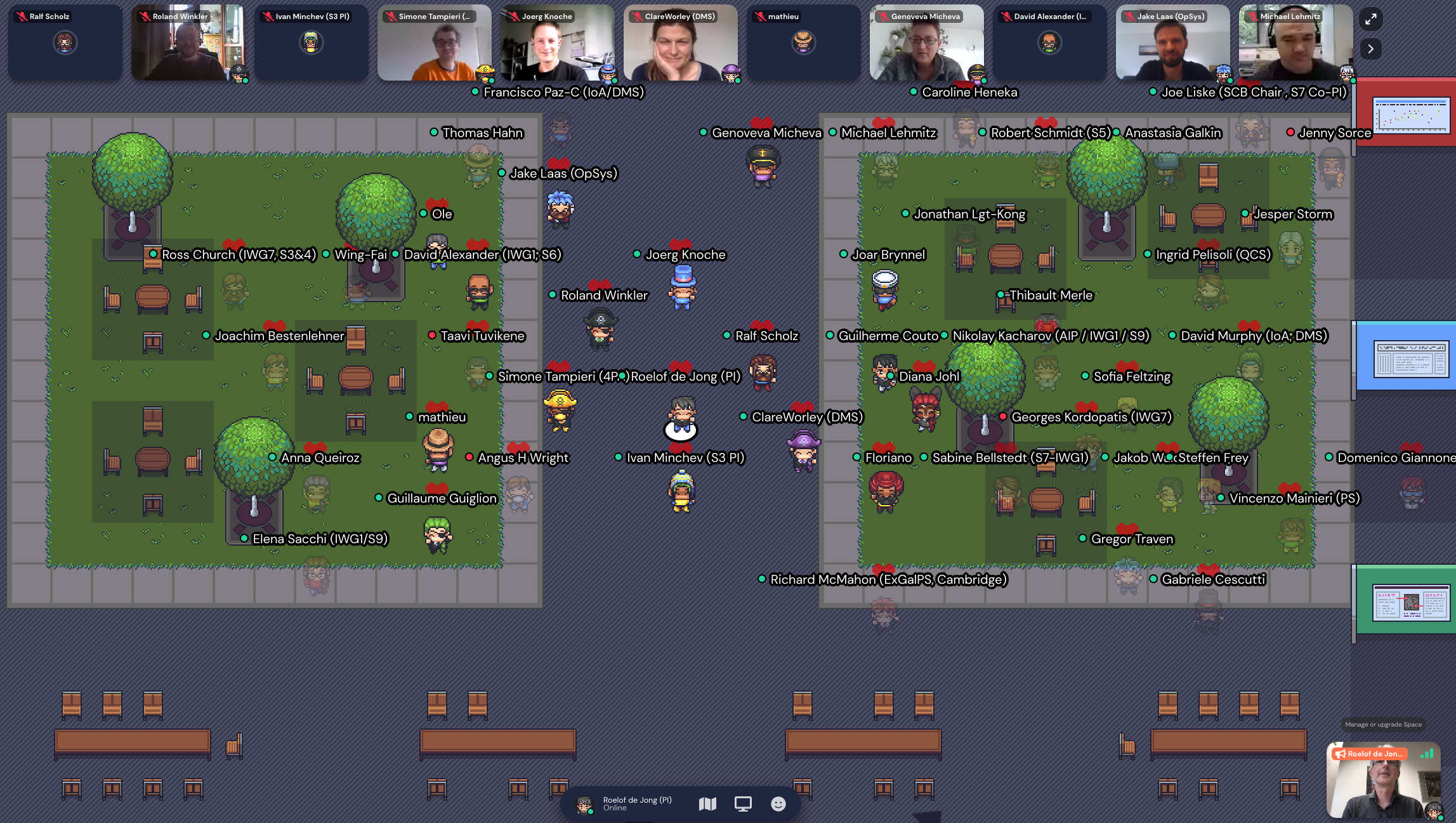News
LRS-A arrives in Potsdam
2022-03-31
4MOST is built around three spectrographs that will collect the spectra of up to 2436 astronomical objects simultaneously. Two of these are identical low-resolution spectrographs (LRS), one is a high-resolution spectrograph (HRS), each fed by 812 fibres. Each spectrograph has a blue, green and red arm, in fixed configuration, and each arm is equipped with a 6k × 6k CCD detector. The two LRS provide continuous wavelength coverage from 390 to 950 nm at a resolution of R > 4000. Once completed, all three spectrographs will be sent to the AIP for system testing and validation.
In December 2021, integration of the first of the three spectrographs (LRS-A) was completed at the 4MOST consortium institute CRAL in Lyon. After acceptance testing, it was disassembled and packed in preparation of shipment to the AIP. On 29 March 2022 the disassembled LRS-A arrived at the AIP on four trucks. A team of five colleagues from CRAL, supported by the 4MOST AIP integration team and two colleagues from MPIA Heidelberg will spend the better part of the three following weeks to unpack and reassemble the spectrograph.
The delivery of LRS-A is a major milestone for the 4MOST project and we are very excited to receive it and follow its re-integration in the integration hall. The two remaining spectrographs are scheduled for delivery to the AIP in August and October of 2022.
See also this AIP press release.
Community Surveys selected
2022-02-04
During the first five years of 4MOST operations, 30% of the available observing time will be used for conducting a set of surveys initiated by the ESO community. The two-step selection process for these surveys, which began in 2019, has now been completed: ESO has announced the selection of 15 Community Surveys, covering a wide range of Galactic and extragalactic science cases. These will now join the existing 10 Consortium Surveys to form the final 4MOST survey programme. The completion of its survey programme is a major milestone for the 4MOST project, and the 4MOST consortium would like to extend a very warm welcome to the Community Survey teams. "We are very glad to have these Surveys on board as they will significantly enhance the scientific scope of the 4MOST survey programme. We are looking forward to a close collaboration in exploiting the many exciting scientific opportunities that lie ahead," said Roelof de Jong, the 4MOST Principal Investigator.
The next step is to integrate the Community Surveys into the existing 4MOST Science Team, and to familiarize the new members with the complexities of 4MOST operations and the management of the project. To this end, the consortium has prepared an extensive "onboarding" programme, consisting of eight online training sessions and culminating in the Science Team meeting in May 2022. The first three of the online sessions will be held twice in order to accommodate participants from all time zones. They will also be recorded and the recordings will be made available here afterwards. The connection details will be distributed by email. The training sessions are open to all members of the Community Surveys as well as to all existing 4MOST members. The programme for the online training sessions is listed below.
| Session 1 |
|
||
| 2022-02-10 | 15:30 – 17:30 CET | ||
| 2022-02-11 | 09:30 – 11:30 CET | ||
| Session 2 |
|
||
| 2022-02-23 | 09:30 – 11:30 CET | ||
| 2022-02-23 | 15:30 – 17:30 CET | ||
| Session 3 |
|
||
| 2022-03-10 | 15:30 – 17:30 CET | ||
| 2022-03-11 | 09:30 – 11:30 CET | ||
| Session 4 | |||
| 2022-03-23 | 09:30 – 11:30 CET | ||
| Session 5 |
|
||
| 2022-04-08 | 09:30 – 11:30 CEST | ||
| Session 6 |
|
||
| 2022-04-22 | 09:30 – 11:30 CEST | ||
| Session 7 |
|
||
| 2022-05-04 | 15:30 – 17:30 CEST | ||
| Session 8 |
|
||
| 2022-05-20 | 09:30 – 11:30 CEST | ||
SPIE 2022
2022-02-03
After COVID-related cancellations of previous SPIE meetings in Japan and San Diego, we are now hoping for a physical SPIE meeting in Montreal during the summer of 2022. 4MOST will of course be strongly represented, with the following abstracts having been submitted:
- 4MOST – the 4-metre multi-object spectroscopic telescope project in the assembly, integration and test phase (R. de Jong et al.)
- 4MOST – MAIT of the High-Resolution-Spectrograph (W. Seifert et al.)
- 4MOST – manufacture, assembly and test of the optical fiber system (A. Kelz et al.)
- 4MOST Calibration System: Design, Assembly and Testing (J. Pragt et al.)
- 4MOST Guiding and Wavefront Sensing cameras – Requirements and early testing (O. Bellido-Tirado et al.)
- 4MOST Low Resolution Spectrograph Alignment (F. Laurent et al.)
- 4MOST Low Resolution Spectrograph Performances (K. Disseau et al.)
- 4MOST WFC_ADC (M.Cunningham, D. Brooks, P. Doel et al.)
- The 4MOST Calibration Plan (G. Micheva et al.)
- Overall performance of AESOP, the 4MOST fibre positioner (J. Brzeski et al.)
- AESOP, the 4MOST fibre positioner – Engineering Principle (J. Brzeski et al.)
- The 4MOST facility control software on its way to a fully fledged subsystem (F. Rothmaier et al.)
LRS-A Local Acceptance Review
2021-12-20
A team from the 4MOST Project Office visited CRAL on 15-16 December 2021 to conduct the Local Acceptance Review (LAR) for the first Low-Resolution Spectrograph (LRS-A). The purpose of the LAR is to assess whether a subsystem is mature and complete before shipping it to the AIP for integration. During the weeks prior to the physical meeting, the deliverable documentation was submitted and reviewed, resulting in a set of comments and questions. At the two-day LAR meeting in Lyon the technical performance and cost were reviewed, the hardware was inspected, the instrument was operated using engineering GUIs, and more. 4MOST project members from MPIA and ESO also participated remotely.
In general, the performance of LRS-A was found to be excellent and no major issues were identified. Issues related to documentation and product assurance are well advanced and on par with expectations at this stage of the project. A list of Action Items has been produced as a result of the LAR. The plan is now for LRS-A to be shipped to Potsdam sometime in Q1 of 2022, with the exact date depending on other system integration activities.
The Project Office wishes to thank the LRS team at CRAL for their dedicated and competent work and superb collaboration. We are already now looking forward to coming back to Lyon when LRS-B is finished!
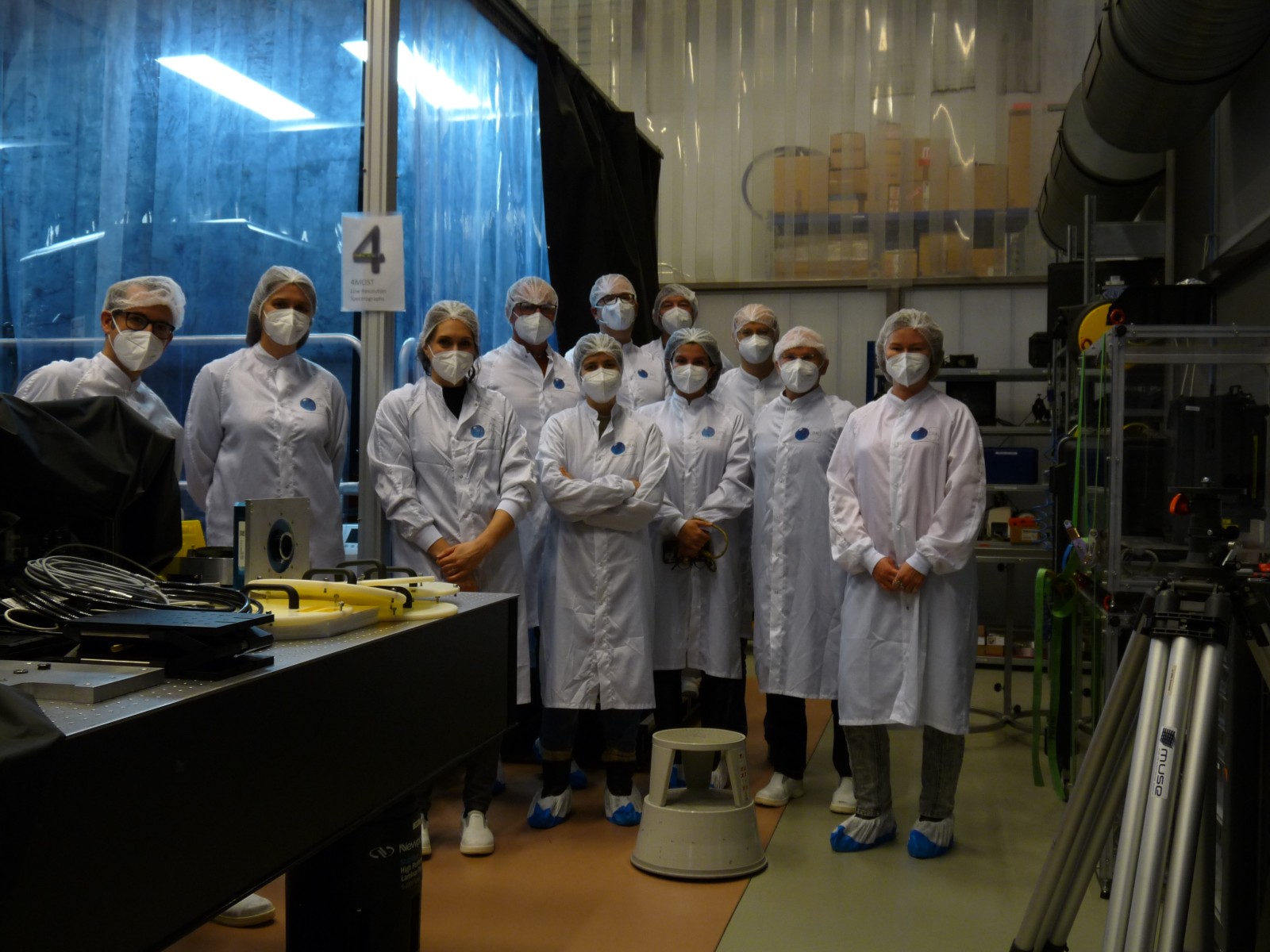
The CRAL and Project Office teams in front of LRS-A in the clean-room. The spectrograph is visible behind the blue airlock. From left to right: Jean-Emmanuel Migniau, Florence Laurent, Karen Disseau, Joar Brynnel, Olga Bellido, Domenico Giannone, Didier Boudon, Aida Ezzati-Amini, Aurelien Jarno, Alban Remillieux, Diana Johl. Other LRS team members not in the picture: Diane Chapuis, Eric Daguisé, Alexandre Jeanneau, Arlette Pécontal, Emmanuel Pécontal, Johan Richard.
4MOST Code of Conduct released
2021-11-30
The 4MOST Code of Conduct (CoC) has recently been approved by the Science Coordination Board, the Executive Board and the ESO Director for Science, and it is now applicable to the work of all 4MOST Project members, including all Consortium Survey members. The CoC establishes important principles like open, respectful communication and a shared commitment to a set of values that include ethical conduct, civility, inclusiveness, and diversity. It also describes escalation procedures in case of conflicts. All 4MOST members will be required to confirm, once a year, that they have read the CoC and that they will adhere to it. The request to confirm the CoC (as well as basic contact details) will be launched soon by the 4MOST User Management System.
The CoC foresees the installment of at least two Ombudspersons, who will provide independent, confidential and neutral advice to members of 4MOST in case of problems or conflicts within the Project. They will also provide current information about services, programs, policies, and procedures. They will try to resolve problems through mediation or by making recommendations to the 4MOST leadership. Nominations for 4MOST Ombudsperson candidates have been solicited by the 4MOST Principal Investigator, Roelof de Jong, on 17 November 2021.
Introducing the new Project Scientists
2021-11-23
An announcement from the Principal Investigator, Roelof de Jong:
It gives me enormous pleasure to let you know that the 4MOST Executive Board has with great enthusiasm approved the two new Project Scientists for the Project:
- Karin Lind (Stockholm University, Galactic PS)
- Jon Loveday (Sussex, extragalactic PS)
Karin has a long history in in the field of Galactic Archeology in general and in modelling of stars and analysing stellar spectra in particular. Since 2015 she has been one of the IWG7 leaders, making sure that the Galactic data reduction pipelines of 4MOST are well prepared. She has a keen interest in measuring the entire Milky Way system with a single yardstick, from the bulge over the full extent of the disk and beyond to the halo and its satellite galaxies, as this will be fundamental in order to understand the interrelationship and formation history of these components. Karin brings many years of experience within 4MOST and other surveys, and is well aware of the importance of creating strong networks that are necessary to make the 4MOST Science Team a tight collaboration.
Jon has been involved in spectroscopic surveys of galaxies since 1985. He has extensive experience in developing survey strategies and in galaxy spectral analysis. He has a keen interest in making sure that the extragalactic 4MOST Surveys are competitive within the broader astronomical community and sees a lot of opportunity in exploiting synergies with other new large facilities in the Southern hemisphere like Rubin Observatory, the SKA pathfinders, and the Antarctic CMB experiments. During OpR2 he was performing quality control for the CR and WAVES Surveys. He sees it as one of his main tasks to bring together the requirements of all the different Surveys in order to find the best compromise for survey strategy.
Please welcome Karin and Jon and help them wherever you can to get them up to speed with the many facets of 4MOST with which they may not be so familiar yet. I am looking forward to collaborating with them in the next few years to achieve important milestones like the onboarding of the Community Surveys, finalising the survey strategy and preparing for instrument commissioning.
Karin and Jon succeed Sofia Feltzing and Richard McMahon, respectively, who have been the 4MOST Project Scientists since 2013. Sofia and Richard have played a key role in shaping the science programme and its organisation from the early Preliminary Design Phase until now. The 4MOST leadership is very grateful for their relentless efforts and their intense dedication to making 4MOST a success.
Save the date: Science Team and All-Hands Meetings 2022
2021-11-10
Please mark your calendars:
The 4MOST Science Team Meeting 2022 will be hosted by UHH in the beautiful city of Hamburg on 23–25 May 2022. This will be the first ST meeting to include the Community Surveys.
The 4MOST All-Hands Meeting 2022 will take place at the AIP in the charming city of Potsdam on 19–23 September 2022.
Both meetings are currently planned as in-person events, but remote access will be available.
AESOP integration
2021-10-29
One of the core components of 4MOST is a fibre positioner, called AESOP (Australian-European Southern Observatory Positioner), which was designed and built by the Australian Astronomical Optics (AAO) Department of Macquarie University in Sydney in the framework of ESO's partnership with Australia. AESOP is the first major subsystem of 4MOST to have arrived at the Leibniz Institute for Astrophysics Potsdam (AIP) for integration.
The AESOP system, which is based on innovative AAO technology, includes the positioner with its 2436 fibres, the positioner housing, the electronics and the electronics enclosures. The fibres are arranged in a hexagonally shaped grid and can be pointed very precisely to collect the light from stars and other objects in the sky. The fibres relay the light to three optical multi-object spectrographs that will measure the spectral properties of the observed objects simultaneously, and thus give clues on the chemical structures and movement of different regions of the Milky Way, among other things. The most important requirement for AESOP is that all fibres must be repositioned within 1 minute with an accuracy of 10 micrometres – about one fifth the thickness of a hair. When the fibres reach their new positions, they are back-illuminated with red light which is recorded by high-resolution cameras to check the positions of the fibre ends before starting a sky exposure. The better the accuracy and speed, the more light from an object will be caught in as little time as possible.
In August, the completed fibre positioner was delivered from AAO in Sydney to AIP in Potsdam. This is the first delivered major component for 4MOST and, once unpacked and reintegrated, it marks the start of 4MOST system integration at AIP's integration hall. "After more than four years of design and analysis work, followed by 3 years of manufacturing and integration, it was very exciting to receive the finished AESOP for system integration," reflects Joar Brynnel, Project Manager of 4MOST at AIP. "Test results from Sydney show excellent performance and we are very happy to start testing AESOP in Potsdam and continue the great collaboration with our partners and colleagues in Australia."
Nominally, the plan was for the AAO team to travel to Potsdam and lead the re-integration and test of the AESOP fibre positioner. Due to COVID travel restrictions in and out of Australia, this was not possible. The situation posed difficult problems for the Potsdam engineering staff, who would normally rely on the collaboration with their Australian colleagues for the unpacking and delicate assembly of AESOP. The teams have now devised an alternative plan where the work will be carried out by staff from the European 4MOST partners under the remote supervision of AAO technical staff. This has started with the arrival of a support team from the Max Planck Institute for Astronomy and the Landessternwarte, both in Heidelberg, on 25 October.
Dr Roelof de Jong, Principal Investigator of 4MOST, emphasises the importance of this step: "It is amazing to reach the milestone of AESOP unpacking and assembly in Potsdam. The fibre positioner is at the heart of the facility and we can now start assembling and testing the full instrument around it before shipping everything to Chile." The completion of the instrument in Europe and delivery to Chile is currently planned for May of 2023.
"AAO-Macquarie University is proud to engage and work closely with major observatories around the world to deliver innovative new instruments based on the new and emerging technologies, like AESOP, that we are creating," said AAO-Macquarie University's AESOP Project Manager Scott Smedley.
The text above has been reproduced (with minor modifications) from this AIP press release. See also this UWA press release and this ESO twitter thread.
Top-level schedule update
2021-10-07
An announcement from the Project Manager, Joar Brynnel:
I would like to communicate a schedule adjustment for the 4MOST project. At its meeting on 23 September 2021 the 4MOST Executive Board (EXB) was presented with a new top-level milestone schedule. After some discussion, the new schedule was acknowledged by the EXB. In summary, we are forced to delay both the Preliminary Acceptance Europe (PAE) and Provisional Acceptance Chile (PAC) milestones by 6+1 months. Six months of delay come from various delays at subsystem level. The additional one month delay is caused by having to re-integrate the fibre positioner AESOP at the AIP with only remote help from the AAO engineers who cannot travel to Potsdam due to the Australian Corona-related travel restrictions. PAE is therefore now scheduled for May 2023, while PAC is now scheduled for March 2024.
Consortium members can download the updated top-level schedule from DocuShare.
4MOST All Hands Meeting 2021
2021-09-27
The 4MOST Consortium came together on 13 – 17 September 2021 for the seventh installment of the annual All Hands Meeting (AHM). Again, as in 2020, this AHM was originally planned to be held at ESO in Garching, but the continuing Corona pandemic forced the event to be held entirely online once more, using a combination of zoom (see above) and gather.town (see below). With 147 registered participants from across the Consortium, the meeting was very well attended. The meeting's programme can be found here and all presentations are available on DocuShare.
Below we have collected some impressions from various corners of the project.
Here are some thoughts from Jenny Sorce, a very active member of the Cosmology Redshift Survey (S8): "With the meeting being entirely online again, I found that gather.town permitted interactions with one (a few) person(s) at a time in a very convenient way. It was very easy to switch from a session to a "private" conversation in an instant and to find the people I needed to talk to."
"The programme was very well set up. I particularly enjoyed the two plenary summary sessions that permitted catching up with the sessions I was not able to attend. Otherwise I mostly attended IWG and extragalactic survey sessions. I must say that contrary to the main sessions, there was no (clear) agenda for most of these sessions. Perhaps it would have been useful to have one in order to be better prepared for the discussions and to stay focused (at least that was my impression). I also really appreciated the afternoon on Project Culture and Values for 4MOST. It was also a special meeting in the sense that some PIs of prospective Community Surveys attended, and it was great to meet some of them. Finally, I was glad to hear that after 2 years of CoViD-19, 4MOST is still reasonably on track. All in all, this meeting was a success and I got all the information I needed to conduct my main tasks for the next year."
The Project Office System Engineer, Olga Bellido Tirado, commented: "Despite of the regular videoconferences I have with our partners, the AHM is an annual event I really look forward to. It is certainly an intense week that requires preparation but, from my point of view, the effort is worthwhile. It's an exceptional moment of exchange of knowledge and experiences in all the project areas. Concerning the facility side of the project, learning about the progress of the individual subsystems in their manufacturing and testing phase has been really exciting. In this second virtual AHM, I think that the use of gather.town has been a great success. It has made all the interaction during the coffee breaks much more enjoyable; giving us back the nice and missed feeling of meeting and chatting with colleagues in the corridor."
David Murphy, a key developer of the Data Management System (DMS) had this to say: "I confess I let out a small groan when I discovered this year's meeting would be held predominantly on gather.town. I'd had a mixed experience with it at last year's AHM, and didn't think it would work very well. Turns out I was completely wrong! An inspired decision by the LOC that really helped to stimulate group discussions and even socialising."
"I was encouraged by how much the project had moved on, despite all the challenges of the past year. From the Operations perspective, we've managed to start analysing engineering data to get a real feel for how the instrumentation will perform. We are now in the process of establishing a dedicated 4MOST Processing Centre for handling all the data that will be generated. A lot of discussions centred around how this will work for various contributors, including the rapidly-developing Public Archive and the target classifier under IWG9. There's still lots for us to do, but I left the meeting full of enthusiasm for the coming year."
"It was only during the final "group photo" on gather.town (see below) that I discovered how to make my avatar "dance" - if we are indeed able to meet in-person next year, I promise that's something I won't replicate in-person!"
Finally, the Project Manager, Joar Brynnel, reflected: "Personally, I have learned a lot during the week, and I am very pleased to note that no unexpected or surprising issues have surfaced. I liked the format of the meeting, and as far as online meetings go I don't think it gets much better than this. An event like this requires good preparation and tight organization. The LOC has done a great job with the preparation and running of the meeting and I would be remiss if I didn't mention the individuals involved: Roelof, Silke, Christine, Diana and Jakob, many thanks for your competent and wonderful support!"
"I am truly looking forward to the AHM 2022, which in the best of worlds will be held as a traditional face-to-face meeting. At that time, we will hopefully be able to present real results from real hardware in the AIP integration hall!"
